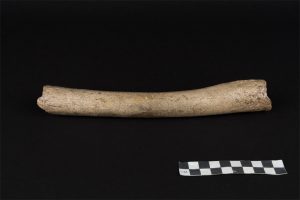Genetic material from the femur of an archaic European hominin collected by researchers provides a timeline for a proposed hominin migration out of Africa that occurred after the ancestors of Neanderthals arrived in Europe by a lineage more closely related to modern humans.

The femur of a Neanderthal was excavated from the Hohlenstein-Stadel Cave in South-western Germany. It shows evidence of being gnawed on by a large carnivore. Radiocarbon dating of the bone revealed it to be 124000 years old, placing it among the oldest to have its mitochondrial DNA analysed to date. The recent study by scientists from the Max Planck Institute for the Science of Human History and the University of Tübingen shows that these hominins interbred with Neanderthals already present in Europe, leaving their mark on the Neanderthals’ mitochondrial DNA, pushing back the possible date of this event to between 470000 and 220000 years ago. Prior research analysing nuclear DNA from Neanderthals and modern humans estimated the split of the two groups at approximately 765000 to 550000 years ago. However, studies looking at mitochondrial DNA showed a much more recent split that occurred 400000 years ago. Moreover, the mitochondrial DNA of Neanderthals is more similar to that of modern humans, indicating a more recent common ancestor, than to that of their close nuclear relatives the Denisovans.

The study shows that within Neanderthal mitochondrial DNA there was more mitochondrial genetic diversity in the Neanderthal population than previously thought. This suggests that the Neanderthal population size once was much bigger than that estimated for the final stage of their existence. Researchers propose a scenario in which after the divergence of Neanderthals and modern human mitochondrial DNA (dated to a maximum of 470000 years ago), but before the divergence between analysed femur and specimen of other Neanderthals happened (dated to a minimum of 220000 years ago), a group of hominins moved from Africa to Europe, introducing their mitochondrial DNA to the Neanderthal population. Thus this intermediate migration out of Africa would have occurred between 470000 and 220000 years ago. The dating was possible, because mitohondria within the cells have their own DNA, separate from the nuclear DNA and this mDNA is inherited from mother to child. This way it can be used to trace maternal lineages and population split times as changes due to mutations in the mitochondrial DNA over time can be used to distinguish groups and also to estimate the amount of time that has passed since two individuals shared a common ancestor, as these mutations occur at predictable rates.
(after Heritage Daily, Annette Günzel, Max Planck Institute for the Science of Human History, Oleg Kuchar & Photo Museum Ulm)